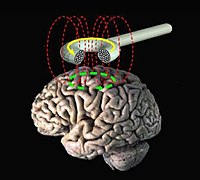
Photo from wikipedia
Deep brain stimulation (DBS) implanted in different basal ganglia nuclei regulates the dysfunctional neuronal circuits and improves symptoms in movement disorders. However, the understanding of the neurophysiological mechanism of DBS… Click to show full abstract
Deep brain stimulation (DBS) implanted in different basal ganglia nuclei regulates the dysfunctional neuronal circuits and improves symptoms in movement disorders. However, the understanding of the neurophysiological mechanism of DBS is at an early stage. Transcranial magnetic stimulation (TMS) can be used safely in movement disorder patients with DBS, and can shed light on how DBS works. DBS at a therapeutic setting normalizes the abnormal motor cortical excitability measured with motor evoked potentials (MEP) produced by primary motor cortical TMS. Abnormal intracortical circuits in the motor cortex tested with paired-pulse TMS paradigm also show normalization with DBS. These changes are accompanied with improvements in symptoms after chronic DBS. Single-pulse DBS produces cortical evoked potentials recorded by electroencephalography at specific latencies and modulates motor cortical excitability at certain time intervals measured with MEP. Combination of basal ganglia DBS with motor cortical TMS at stimulus intervals consistent with the latency of cortical evoked potentials delivered in a repetitive mode produces plastic changes in the primary motor cortex. TMS can be used to examine the effects of open and closed loop DBS. Patterned DBS and TMS delivered in a repetitive mode may be developed as a new therapeutic method for movement disorder patients.
Journal Title: Clinical Neurophysiology
Year Published: 2019
Link to full text (if available)
Share on Social Media: Sign Up to like & get
recommendations!